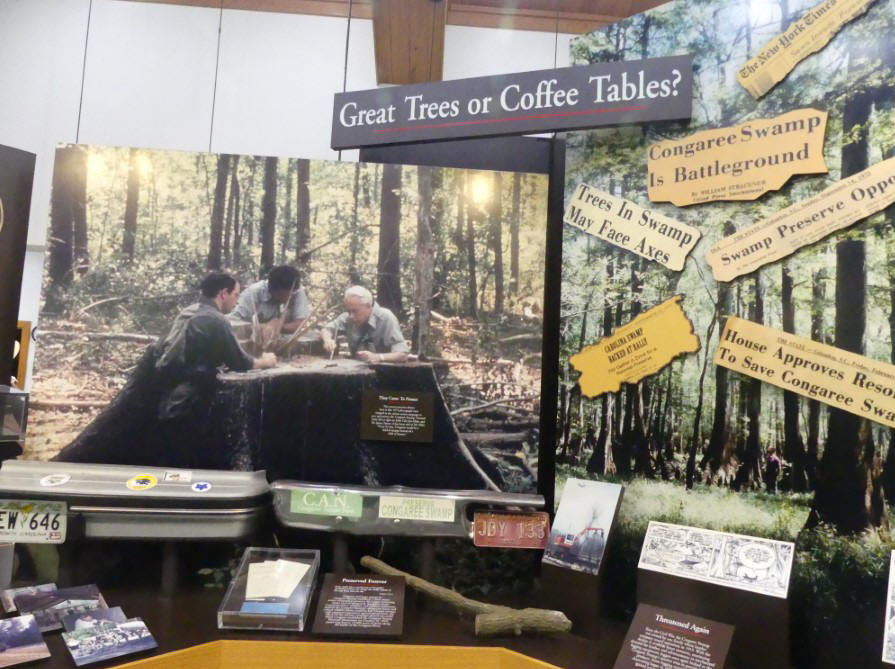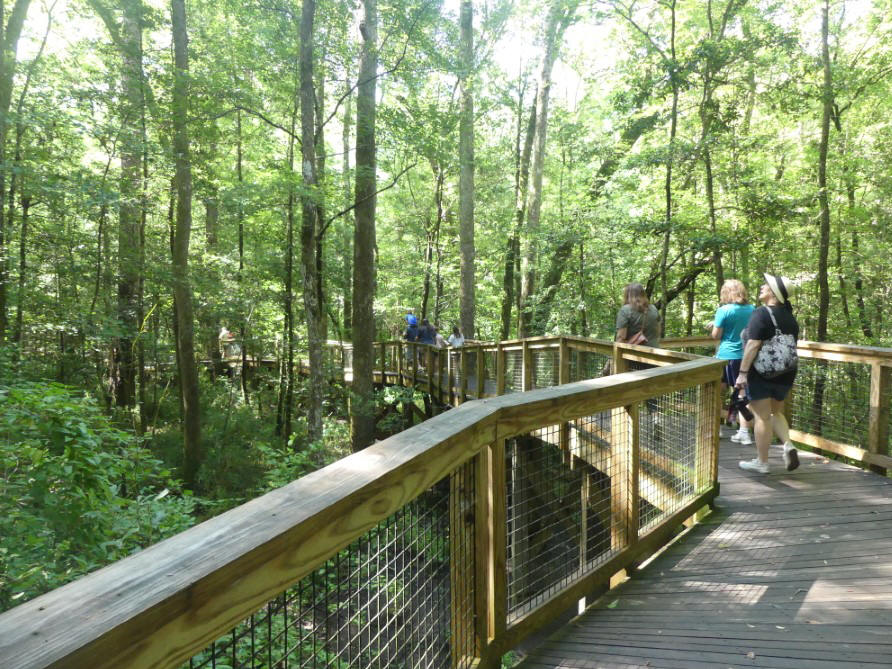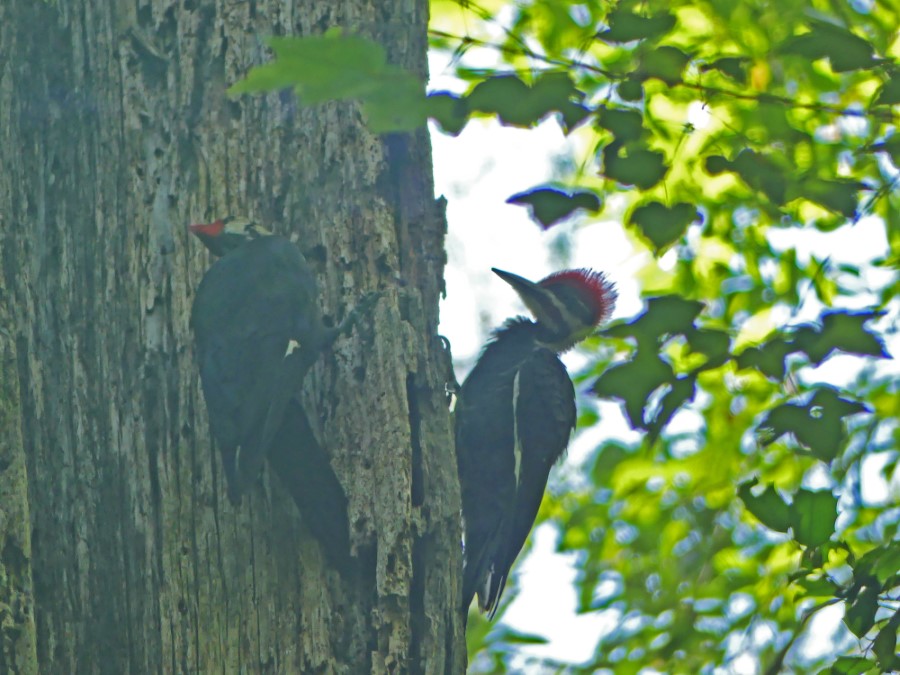Congaree National Park: An Under Rated Treasure
Story and photos
by Kathleen Walls

South Carolina has an under-appreciated
treasure in its heartlands. Congaree National Park in the
Midlands, just about 18 miles from Columbia, is South
Carolina's only national park. It's the largest preserved
section of old growth bottomland hardwood forest in the
southeastern United States providing a unique ecosystem that
supports native wildlife, including bobcats, deer,
armadillos, turkeys, alligators, snakes, feral hogs, and
over 2000 bird species, one of the largest number in the
country, and ancient trees. There is a small museum in the
visitor's center telling the history and wildlife found
there. The park offers over 25 miles of hiking trails and
2.5 miles of boardwalks. There's a canoe trail where you can
bring your own kayak or canoe and paddle or rent one. It
also allows primitive camping. Sadly, it's the
third-least-visited park east of the Mississippi.

We visited it last week, and I was
amazed at the beauty. Even the parking area is filled with
giant trees, so the picnic tables are shaded. The day we
visited, we had an extra treat. The Horseless Carriage Club
was meeting there and the parking lot was lined with dozens
of old beauties.
Visitors Center

Inside the visitors' center, the museum
has exhibits about the park. There's a model of a huge
hollow cypress tree you can step inside. A video tells you
to be sure to get a trail map and take plenty of water on
your hike into the forest.

One exhibit takes you back to the early
history and explorers of the area. Naturally there is a
wildlife one with a cute raccoon and a blue heron. There is
an exhibit dedicated to Harry Hampton, a writer and
outdoorsman who first began advocating for preservation of
the Congaree floodplain area. You'll see his old fishing
equipment and the Royal typewriter he wrote on. He was born
in 1897 when much of South Carolina was still natural, but
what is now the park was then owned by Francis Beidler a
wealthy lumberman, and he grew rich on the harvest of
cypress trees. In spite of opposition from lumbermen and
their political friends, he finally succeeded. Just four
years before his death, Hampton saw the area preserved by
congress and named Congaree Swamp National Monument in 1976.
In 2003, Congress officially designated it a National Park.
The visitors' center is named for Hampton.
Boardwalk Trail

The boardwalk trail we took begins
behind the center. Be sure to use the restroom just outside
the center before you start, as once you are on the
boardwalk, you leave civilization behind. There is only
beautiful swampland beneath you. Although the land is very
wet, there are trees and brush all around. Congaree's tree
canopy is higher than many other old-growth forests reaching
an average height of 100 feet, the tallest in the eastern
U.S. One of the biggest components is the cypress trees.
They are only found in the southeastern United States,
beginning in Louisiana and Mississippi.
Wildlife

Of course, we were all searching for
wildlife. Since it was midday and rather hot, that was a
challenge. We saw what looked like footprints, possibly a
raccoon, in the mud below. At first we heard birds and saw a
few in flight, then we hit the jackpot with a beautiful,
barred owl. I managed to get a few pictures as he rested
between flights. The barred owl is known for its distinctive
cry, which sounds like "Who cooks for you? Who cooks for
you?"

A few yards down the boardwalk, there
were a pair of pileated woodpeckers busy digging their lunch
of tasty insects from a well pecked tree trunk. And
speaking of inscets, there were some interstinglooking
spiders.

Other Park Activities
I would have loved to have more time to
spend at this park. I could have done some kayaking along
its Blue Trail, which is a 50-mile kayak/trail that runs
from downtown Columbia to the park. There are outfitters in
Columbia who rents canoes
and kayaks if you don't have your own. Other park events are a nocturnal
Ranger-guided Owl Prowl, and they host an annual Firefly
Festival in May where you get to see Photuris frontalis,
a local type of firefly that flashes in unison.
For more about another national park,
My friend and fellow travel writer, Jo
Clark, says her favorite National Park is the Blue Ridge
Parkway. When people take a road trip on the Blue
Ridge Parkway, most probably never realize that it is a
part of the National Park Service. It is known as America’s
Favorite Drive for good reason: the road wraps through
469 miles of the Blue Ridge Mountains in the Appalachian
Mountain chain. Starting at the Shenandoah National Park in
Virginia, the drive ends at the Great Smoky Mountains
National Park in North Carolina. Below is one of her photos
of Lovers Leap on the Blue Ridge Parkway.
The Blue
Ridge Parkway is the longest single-unit planned
road in the United States. It was planned in 1936
and took more than 50 years to complete. The
National Park Service has managed it since it opened
to vehicles.
One of the
best features of the Blue Ridge Parkway is its
access to places of interest tucked away in the
mountainside. These include quaint towns, rock
churches, waterfalls, churches covered in frescos,
and breathtaking mountain views. Along the edges,
there are interesting bed and breakfast inns and
wineries, as well as wildlife like black bears,
white-tailed deer, and over 200 species of birds.
Read more about the Blue Ridge Parkway and the
secrets it hides in this article by Jo: The Stunning
469-Mile Blue Ridge Parkway is America's Favorite
Drive
.

Public Disclosure
Please Read
FTC has a law
requiring web sites to let their readers know if any of the
stories are "sponsored" or compensated. We also are to
let readers know if any of our links are ads. Most are not.
They are just a way to direct you to more information
about the article where the link is placed. We have several ads
on our pages. They are clearly marked as ads. I think
readers are smart enough to know an ad when they see one but to
obey the letter of the law, I am putting this statement here to
make sure everyone understands. American Roads and Global
Highways may contain affiliate links or ads. Further, as their
bios show, most of the feature writers are professional travel
writers. As such we are frequently invited on press trips, also
called fam trips. On these trips most of our lodging, dining,
admissions fees and often plane fare are covered by the city or
firm hosting the trip. It is an opportunity to visit places we
might not otherwise be able to visit. However, no one tells us
what to write about those places. All opinions are 100% those
of the author of that feature column.



